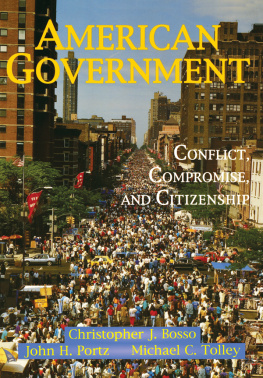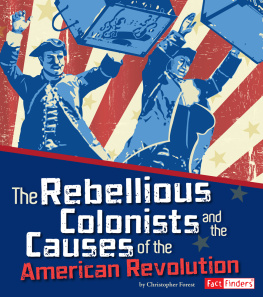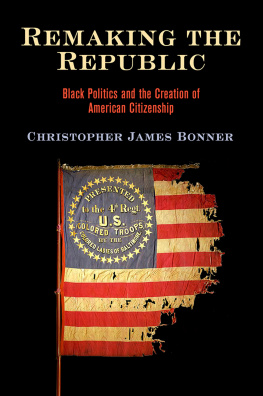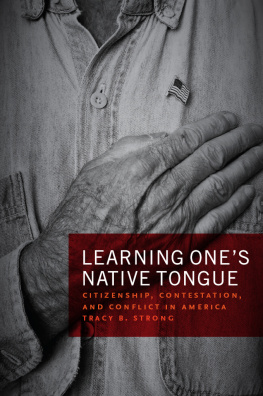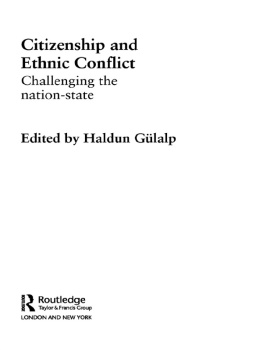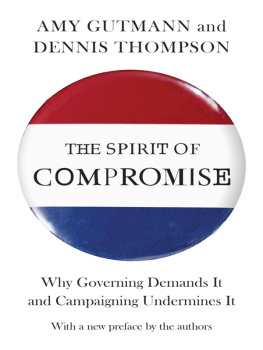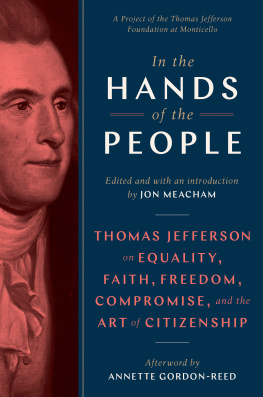To our teachers, and to our students
Photo credits:
p. 2: Ellen Senisi, The Image Works; 4: George Bellerose, Stock Boston; 8: Les Stone, Corbis Sygma; 23: Wesley Hitt, Liaison Agency; 28: Bill Greenblatt, Liaison Agency; 29: Reuters/Blake Sell, Archive Photos; 42: John Giordano, Saba; 50: Archive Photos; 55: Hulton Getty Picture Library, Liaison Agency; 61: Hulton Getty Picture Library, Liaison Agency; 71: U.S. Senate/CNP, Archive Photos; 86: Matthew Neal McVay, Stock Boston; 94: Wally McNamee, Sygma; 97: Ralf-Finn Hestoft, Saba; 106: Daemmrich, The Image Works; 110: Corbis/Bettmann; 134: Tim Barnwell, Stock Boston; 145: Russell Lee/Hulton Getty Picture Library/Liaison Agency; 152: Paoni/Contrasto, Saba; 160: www.stormfront.org; 162: Daemmrich, The Image Works; 167: Fugliano, Liaison Agency; 183: A. Ramey, Stock Boston; 187: Ira Wyman, Corbis Sygma; 187: Reuters/T. Bochatey, Archive Photos; 187: B. Kraft, Corbis Sygma; 187: Darren Carroll, Liaison Agency; 194: Archive Photos; 199: Steven Rubin, The Image Works; 208: Reuters/Donald Winslow, Archive Photos; 231: Bob Daemmrich, Stock Boston; 247: Hulton Getty Picture Library, Liaison Agency; 258: Daemmrich, The Image Works; 279: John Mantel, Sipa Press; 286: Corbis/Bettmann; 290: Ken Hawkins, Corbis Sygma; 294: Alain McLaughlin, Impact Visuals; 298: Joseph Fitzgerald, Sipa Press; 310: James Nubile, The Image Works; 326: Jeffrey Markowitz, Corbis Sygma; 328: Matthew Borkoski, Stock Boston; 340: A. Lichtenstein, Corbis Sygma; 349: Reuters/Mark Wilson, Archive Photos; 362: Senate Pool, Saba; 374: J. L. Atlan, Corbis Sygma; 376: Clark Campbell, Sipa Press; 386: Archive Photos; 387: J. L. Atlan, Corbis Sygma; 389: Agence France Presse, Archive Photos; 409: Wally McNamee, Corbis Sygma; 421: Dion Ogust, The Image Works; 423 Gregg Mancuso, Stock Boston; 425: Greg Smith, Saba-Pool; 430: Richard Ellis, Corbis Sygma; 435: L. Kolvoord, The Image Works; 439: Sheppard Sher-bell, Saba; 453: Daemmrich, The Image Works; 466: Pixel by Pixel; 469: David James, Kobal Collection; 478: Reuters/Steve Jaffe, Archive Photos; 482: Corbis Sygma; 486: Hulton Getty Picture Library, Liaison Agency; 491: Meyer Liebowitz/New York Times Co., Archive Photos; 508: McLaughlin, The Image Works; 512: Jacksonville Journal-Courier, The Image Works; 518: Gyori Antoine, Corbis Sygma; 521: courtesy Project Vote Smart; 522: Wade Goddard, Corbis Sygma; 526: Dion Ogust/The Image Works; 530: Jim West, Impact Visuals
First published 2000 by Westview Press
Published 2018 by Routledge
711 Third Avenue, New York, NY 10017, USA
2 Park Square, Milton Park, Abingdon, Oxon OX14 4RN
Routledge is an imprint of the Taylor & Francis Group, an informa business
Copyright 2000 by Taylor & Francis
All rights reserved. No part of this book may be reprinted or reproduced or utilised in any form or by any electronic, mechanical, or other means, now known or hereafter invented, including photocopying and recording, or in any information storage or retrieval system, without permission in writing from the publishers.
Notice:
Product or corporate names may be trademarks or registered trademarks, and are used only for identification and explanation without intent to infringe.
A CIP record for this book is available from the Library of Congress.
ISBN 13: 978-0-8133-6871-9 (pbk)
Any decision to add to the towering pile of textbooks on American government and politics is either a sign of simple lunacy or, believe it or not, because we had an overriding sense of purpose. Although you do have to be a little crazy to take on such a daunting task, we did approach this project with several goals in mind.
A Convenient Length Our first goal was to design a text that would occupy a middle ground between the massive hardback texts that traditionally have been used in college courses on American politics and the short, almost terse, basics texts that offer little more than a litany of facts. For many of usstudents and teachers alikethe big texts are too long: you often dont get to use all of the textbook because you run out of time, no matter how long the school term is. These books cost a lot, so many students simply didnt buy them. And they included so much information that both teachers and students had a hard time deciding what was important in general, not just for the final examand what was merely interesting to diehard politics junkies. These books are excellent sources, but they have real shortcomings for classroom use.
The shorter basics texts are, to be charitable, often sketchy and uninteresting. More than one of our students, when asked about the one or the other of these texts, typically responded with a single word: boring. Now, we dont presume that every texteven this oneis a literary classic, but being boring is a major indictment.
Thus, our first goal was to try to offer the essential information about and analysis of American politics without being boring. OK, so we may not always succeedyou may not be as excited as we are about discussing the structure of the federal bureaucracybut we try to keep the reader in mind. We also tried to keep the length of the text within reasonable limits so that it can be used either as a core text, particularly for shorter terms (such as quarter systems, summer sessions, or evening courses), or as one of several books in a semester system course.
A Focus on Core Questions The goal of keeping the texts length within reasonable limits forced us to think hard about what was fundamental versus what is merely interesting. For example, in parties in American politics. The same consideration of core questions runs through each of the chapters.
A Theme That Works We also wanted to explain American politics by using a theme that didnt leave the reader confused, alienated, or cynical. To be blunt about it, some texts rely on themes that are so complicated that only a trained political scientist can understand them, or are so subtle that students never quite get the point. Some themes are so radical that too many students automatically turn off their brains when confronted by an alien perspective. This tendency is not exactly a sign of intellectual openess, to be sure, but it happens too often to be ignored. And, frankly, some themes describe politics in ways that leave the impression that none of this is worth studying in the first place.
We disagree, and use a theme of conflict and compromise throughout this text to show, first, how politics is a natural part of any free society and, second, that the end result of politics frequently is some sort of compromise, some mutually beneficial outcome, that leaves most people satisified that some progress was made. This is not always true, mind you, but it happens enough to make us believe that, in a democracy, compromise is the norm, not the exception.
More important, the theme is a hopeful one. It is not naive: we dont assume that everyone is always honest, good, or even very smart. But neither do we begin with the assumption that politics is dirty, politicians are crooks, and voters are morons. It isnt, and they arent, and the sooner we get away from such shallow assumptions the better off well all be in the end. After all, politics is important: it is the process by which we try to transcend our conflicts in a peaceful manner. The alternatives are far worse.
So count us among the believers who think that politics is too important to be dismissed as irrelevant or stupid. We dont expect that students will come away from this book wanting to become activists, politicians, or, even, political scientistsalthough we might like itbut we do hope it will make them think more about their role in the American political system.

